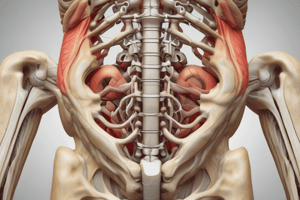Podcast
Questions and Answers
What is the primary function of ligaments in the body?
What is the primary function of ligaments in the body?
- Control blood flow
- Connect bones to other bones (correct)
- Connect muscles to bones
- Generate heat
Which region of the body do the sacro-tuberous ligament and sacro-spinous ligament primarily support?
Which region of the body do the sacro-tuberous ligament and sacro-spinous ligament primarily support?
- Neck and shoulders
- Lower back and hips (correct)
- Elbows and wrists
- Knees and ankles
What is the anatomical connection of the sacro-tuberous ligament?
What is the anatomical connection of the sacro-tuberous ligament?
- Between the humerus and radius
- Between the femur and tibia
- Between the ischial tuberosity and first coccygeal vertebrae (correct)
- Between the ilium and sacrum
How do ligaments contribute to movement in the body?
How do ligaments contribute to movement in the body?
Which muscle is posteriorly attached by the sacro-tuberous ligament?
Which muscle is posteriorly attached by the sacro-tuberous ligament?
What is one of the main functions of the sacro-spinous ligament?
What is one of the main functions of the sacro-spinous ligament?
What is the primary attachment of the gluteus maximus muscle on the sacrum?
What is the primary attachment of the gluteus maximus muscle on the sacrum?
Which ligament plays a significant role in maintaining the stability of the lower back and hips?
Which ligament plays a significant role in maintaining the stability of the lower back and hips?
What can a tear in the sacro-spinous ligament lead to?
What can a tear in the sacro-spinous ligament lead to?
Which ligament supports the gluteal muscles, particularly during activities like walking uphill?
Which ligament supports the gluteal muscles, particularly during activities like walking uphill?
Why is it crucial to understand the function of sacro-tuberous and sacro-spinous ligaments in the medical field?
Why is it crucial to understand the function of sacro-tuberous and sacro-spinous ligaments in the medical field?
Injuries to which structures can lead to difficulties in activities like walking?
Injuries to which structures can lead to difficulties in activities like walking?
Study Notes
Ligaments of the Gluteal Region: An In-depth Look at the Sacro-Tuberous and Sacro-Spinous Ligaments
The human body is intricately designed with various tissues and structures that work together to support our movements and maintain stability. Among these elements are the ligaments, which serve as strong bands of fibrous tissue connecting bones to other bones. This article delves into the fascination of the musculoskeletal system, particularly focusing on two important ligaments within the gluteal region: the sacro-tuberous ligament and the sacro-spinous ligament.
Understanding Ligaments
Ligaments play a pivotal role in providing stability to the joints. They do this by resisting excessive movement and thus preventing injuries. Additionally, they contribute to movement by limiting or controlling joint range of motion. When it comes to supporting the lower back and hips, the sacro-tuberous ligament and sacro-spinous ligament are key players.
The Sacro-Tuberous Ligament
The sacro-tuberous ligament is a strong band of connective tissue that stretches between the ischial tuberosity and the first coccygeal vertebrae. It serves as one of the primary stabilizers of the pelvis and contributes to the posterior attachment of the gluteus maximus muscle.
This ligament is crucial in supporting the weight of the upper body when the individual is standing or sitting. It is therefore essential in maintaining the stability and alignment of the hip joint, which is responsible for movements like walking, running, and jumping.
The Sacro-Spinous Ligament
The sacro-spinous ligament is a broad, flat ligament that extends from the sacrum to the spinous process of the first coccygeal vertebrae. It serves as the principal attachment of the gluteus maximus muscle on the sacrum and helps to stabilize the sacrum and coccyx.
The sacro-spinous ligament plays a significant role in maintaining the stability of the lower back and hips. It works in conjunction with the sacro-tuberous ligament to support the gluteal muscles, which are crucial for various activities that require strength, such as walking uphill or carrying heavy loads.
Clinical Significance
Understanding the function and importance of these ligaments is crucial in the medical field. Injuries or damage to these structures can lead to various health issues. For instance, a tear in the sacro-spinous ligament can cause pain and discomfort, leading to limited mobility and difficulties in activities like walking.
In summary, the sacro-tuberous ligament and the sacro-spinous ligament are vital components of the human body. They contribute to the stability of the pelvis and lower back, supporting movements and maintaining joint alignment. Understanding their functions and potential injuries can aid in developing targeted exercises and treatments for individuals experiencing issues in these areas.
Studying That Suits You
Use AI to generate personalized quizzes and flashcards to suit your learning preferences.
Description
Explore the pivotal role of the sacro-tuberous and sacro-spinous ligaments in stabilizing the pelvis and supporting movements in the gluteal region. Learn about their anatomy, functions, and clinical significance in maintaining joint stability and preventing injuries.




